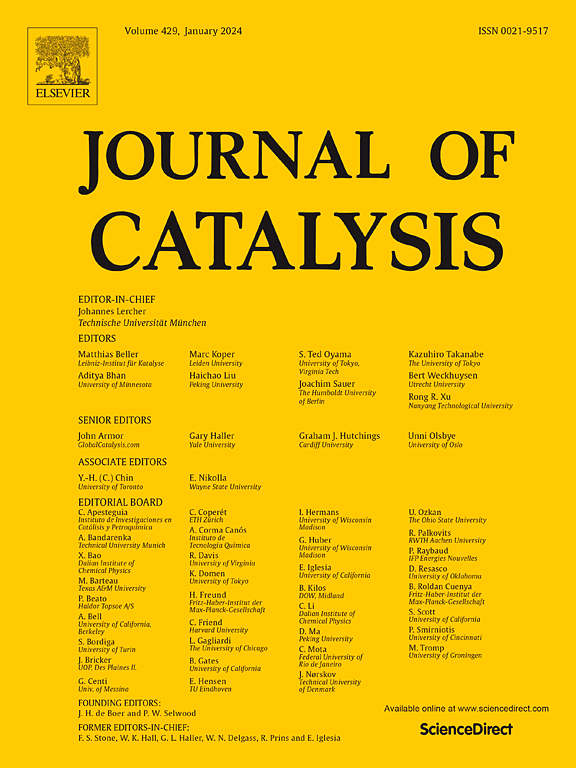稳定的仿生Mn4O4立方分子光催化剂,用于有效的可见光驱动C-H直接三氟甲基化
IF 6.5
1区 化学
Q2 CHEMISTRY, PHYSICAL
引用次数: 0
摘要
受光系统II与立方Mn4CaO5团簇天然出氧配合物的启发,目前对类似立方Mn4CaO5团簇的光催化剂的研究相对较少。因此,混合价Mn4CaO5模拟物的开发引起了人们的极大兴趣。本文以MnBr2和1- me -苯并咪唑-2-酰基甲醇酸盐(Hmbm)为原料,通过单晶晶体学确定了Mn4O4的结构,成功制备了[Mn4(mbm)4(CH3CH2OH)4Br4]·[Mn4(mbm)4(CH3CH2OH)3(H2O)Br4] (Mn4Br) Mn4O4立方簇。Mn4O4立方核由一个八面体Mn(II)中心组成,由单阴离子的醇氧原子和咪唑氮原子螯合,由醇/水和溴离子配位。Mn4Br在可见光下表现出三氟甲基化反应活性。Mn4Br在I2溶液下氧化形成最小尺寸的混合价Mn4Br-I2,由于具有更高的氧化还原性能和更低的电荷转移阻力,在C-H活化的三氟甲基化反应中表现出更高的活性。本研究为合成具有混合价态的Mn4CaO4拟合物结构提供了一种新的高效策略,并开发了其在光催化有机合成中的应用。本文章由计算机程序翻译,如有差异,请以英文原文为准。


Stable bio-inspired Mn4O4 cubic molecular photo catalyst for effective visible light-driven C–H direct trifluoromethylation
Inspired by the natural oxygen-evolving complex of photosystem II with a cubic Mn4CaO5 cluster, there is relatively little research on photo catalysts that closely resemble the cubic Mn4CaO5 cluster. Therefore, the development of mixed-valence Mn4CaO5 simulacrums has sparked great interest. Herein, we successfully obtained a Mn4O4 cubic cluster with [Mn4(mbm)4(CH3CH2OH)4Br4]·[Mn4(mbm)4(CH3CH2OH)3(H2O)Br4] (Mn4Br) by using MnBr2 and 1-Me-benzo[d]imidazol-2-yl)methanolate (Hmbm) with its structure determined by single crystal crystallography. The Mn4O4 cubic cores consists of an octahedral Mn(II) center chelated by the alkoxide oxygen and imidazole nitrogen atoms from monoanionic mbm− and coordinated by alcohol/H2O and bromide ion. Mn4Br was found to exhibit activity for trifluoromethylation reaction under visible light. The oxidization of Mn4Br under I2 solution led to the formation of mix-valent Mn4Br-I2 with smallest sizes, which exhibited improved much higher activity for the C–H activated trifluoromethylation reaction due to the much higher redox performance as well as a lower charge-transfer resistance. This study provides a new and efficient strategy for the synthesis of Mn4CaO4 simulacrum structures with mixed valent states and develops its application in photocatalytic organic synthesis.
求助全文
通过发布文献求助,成功后即可免费获取论文全文。
去求助
来源期刊

Journal of Catalysis
工程技术-工程:化工
CiteScore
12.30
自引率
5.50%
发文量
447
审稿时长
31 days
期刊介绍:
The Journal of Catalysis publishes scholarly articles on both heterogeneous and homogeneous catalysis, covering a wide range of chemical transformations. These include various types of catalysis, such as those mediated by photons, plasmons, and electrons. The focus of the studies is to understand the relationship between catalytic function and the underlying chemical properties of surfaces and metal complexes.
The articles in the journal offer innovative concepts and explore the synthesis and kinetics of inorganic solids and homogeneous complexes. Furthermore, they discuss spectroscopic techniques for characterizing catalysts, investigate the interaction of probes and reacting species with catalysts, and employ theoretical methods.
The research presented in the journal should have direct relevance to the field of catalytic processes, addressing either fundamental aspects or applications of catalysis.
 求助内容:
求助内容: 应助结果提醒方式:
应助结果提醒方式:


